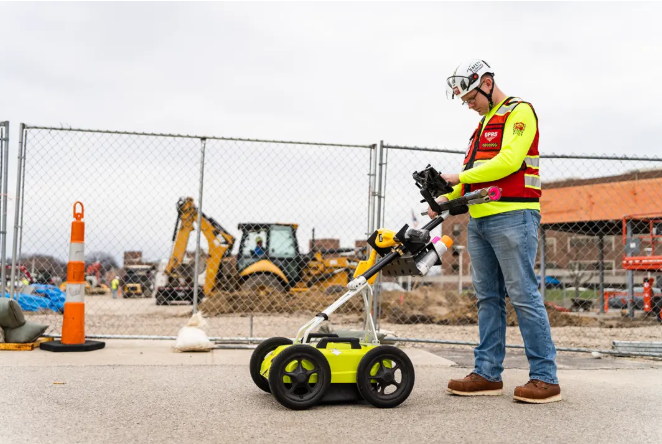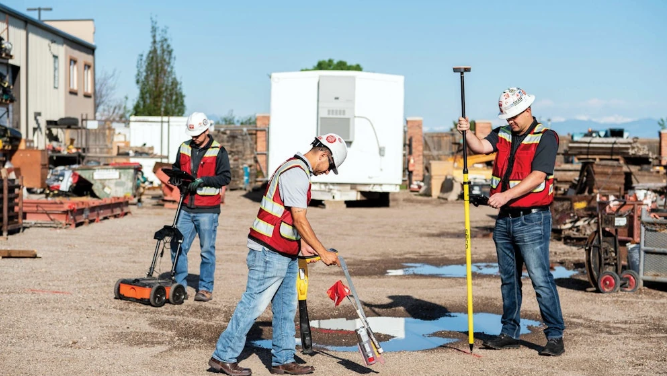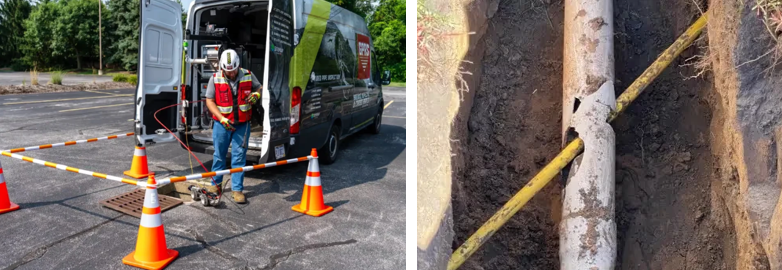Municipalities increasingly require pre and post-project CCTV inspections after horizontal directional drilling to detect cross bores and protect public safety.

Best Practices for Pre and Post-Installation for Directional Drilling Projects
What Is Horizontal Directional Drilling (HDD)?
Horizontal Directional Drilling (HDD) is a trenchless construction method used to install underground utilities—such as fiber optic cables, conduits, water, gas, and sewer lines—beneath roads, rivers, and infrastructure. HDD reduces surface disruption and environmental impact by using precision-guided drilling to create a controlled horizontal bore path, which is then enlarged for utility placement.
HDD in the Telecom Industry
HDD is critical in telecom infrastructure for:
- Fiber optic installations
- 5G expansion
- Rural broadband deployments
- Smart city connectivity
- Data center interconnects
Its non-invasive approach minimizes surface disruption while reducing project timelines and costs.
What Are the Key Benefits of HDD?
- Trenchless operation: Reduces the need for open excavation
- High precision: Enhances utility placement accuracy
- Cost efficiency: Minimizes restoration and cleanup
- Reduced environmental impact: Preserves surface features and ecosystems
What are the Best Practices for Pre-Installation with HDD?
Site Assessment & Utility Locating
- Partner with a professional utility locating service near you, like GPRS, to identify subsurface utilities using GPR and EM locators and map them.
- Mark overhead utilities and confirm aerial hazard zones.
- Perform geotechnical soil assessments to inform equipment and fluid choices.
- Use vacuum excavation or hand digging to expose critical utilities.
- Conduct pre-project sewer inspections with CCTV to detect cross bores or structural issues.
- Survey the bore path and confirm alignment to avoid existing infrastructure.
- Plan to minimize environmental and utility conflicts.

GPRS can locate & map subsurface utilities on your site using ground penetrating radar (GPR) and electromagnetic (EM) locating to ensure you know where your utilities are, including depths where possible, before any excavation, including HDD.
Equipment Readiness
- Verify all fluid levels (drilling, hydraulic, coolant, fuel).
- Lubricate and inspect mechanical components.
- Check hoses, belts, electricals, and connections for wear.
- Replace or repair any worn drill string components.
- Confirm safety systems (e-stop, alarms, guards) are fully operational.
Regulatory Compliance
- Obtain permits at local, state, and federal levels.
- Follow OSHA, EPA, DOT, and local excavation standards.
- Maintain clearance: 5 ft. from distribution lines, 10 ft. from transmission lines.
- Use proper PPE in accordance with OSHA regulations.
- Submit as-built drawings and documentation to authorities.
Equipment Calibration & Setup
- Match equipment and tooling to soil conditions.
- Calibrate tracking and locating systems.
- Assign spotters when working near overhead lines or tight areas.
- Cap exposed conduit ends to prevent contamination.
- Create a contingency plan for unexpected conditions.
What Are the Post-Installation Best Practices for HDD?
Site Security
- Secure open bore pits with fencing, barricades, and signage.
Bore Path Verification
- Use tracking technology to confirm bore path alignment.
- Pressure test pipelines or fiber installations for integrity and performance.
Ground Stability & Restoration
- Seal entry/exit points and fill annular spaces with grout or stabilizer.
- Monitor for settlement, shifting, or surface heaving.
- Restore pavement, landscaping, and structural surfaces to original condition.
Final Documentation
- Produce accurate as-built records with depth, alignment, and GPS data.
- Report deviations and submit compliance documentation to regulators.

GPRS Services for HDD Projects
Utility Locating Services
GPRS uses GPR and EM locating technology to achieve over 99.8% accuracy in identifying underground utilities. With over 500,000 projects completed, GPRS Project Managers are trained through the Subsurface Investigation Methodology (SIM):
- 320+ hours of field training
- 80+ hours of classroom instruction
- Nationwide availability
This ensures accurate utility identification and project risk mitigation.
Telecom Installation Support
Utility locating is essential for:
- Telecom site surveys
- Bore path planning
- Subsurface mapping
- MDU infrastructure deployment
- Telecom and fiber optic line installation
Read the Article: Updated utility maps accurately captured existing underground utilities to allow for the safe installation of new power distribution lines in a community.
Sewer Inspection Services
GPRS provides CCTV sewer inspections before and after drilling:
- NASSCO-certified inspections
- Detection of pre-existing damage or cross bores
- Documentation for municipal and regulatory compliance
GPRS is the only nationwide provider with SIM- and NASSCO-certified inspectors in all major U.S. markets.
Municipal Requirements for Cross Bore Prevention
Why Video Pipe Inspections (VPI) Matter
Municipalities increasingly require pre- and post-project CCTV inspections to detect cross bores and protect public safety.
Pre-Drill VPI
- Detects existing cross bores
- Identifies conflicts with gas, water, or sewer lines
- Helps realign bore paths to avoid hazards
Post-Drill VPI
- Verifies that new installations did not intersect existing utilities
- Confirms compliance with local regulations
- Provides documentation to municipalities
Benefits of VPI Requirements
- Public Safety: Prevents explosions, leaks, and contamination
- Regulatory Compliance: Meets municipal safety codes
- Reduced Liability: Lowers risk of damage claims
- Utility Protection: Preserves existing infrastructure integrity
Case in Point: The City of Fremont, CA mandates CCTV inspections for all directional drilling near sewer lines.

Partner with GPRS for Safe, Compliant HDD Projects
CCTV sewer inspection services, like GPRS’ Video Pipe Inspection, assess sewer laterals before and after drilling to help you target repairs.
GPRS offers:
- Nationwide utility locating with 99.8%+ accuracy
- NASSCO-certified CCTV sewer inspections
- SIM-trained Project Managers
- Regulatory documentation and bore path verification
Contact GPRS today for expert utility locating and inspection services that reduce risk and ensure project success.
